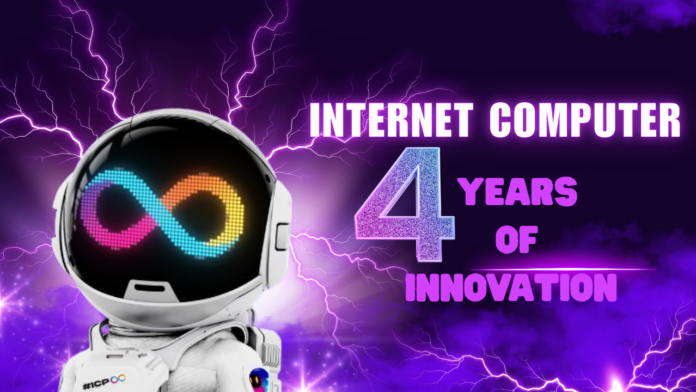Four years after it went live, the Internet Computer continues to push the limits of what blockchains can do. The anniversary isn’t just a nod to longevity in a fast-moving industry—it’s a marker of technical ambition and stubborn consistency. What started as a big idea to rethink the internet stack has matured into an ecosystem delivering new tools, real-world applications, and a growing developer base.
Over the past year, the Internet Computer Protocol (ICP) has grown deeper roots across infrastructure, tooling, AI integration, and developer onboarding. The numbers help paint the picture. The network is now supported by 92 independent node providers across 113 data centres in 34 countries. More than 4,300 GitHub repositories were opened over the past year—a 19% year-on-year increase—while Internet Identities saw a 14% jump, reaching over 260,000. According to Token Terminal, OpenChat alone has over 233,000 users, with thousands opting in to identity verification through DecideAI.
The project’s foundation, DFINITY, has continued to scale its research operations, notably expanding its presence in the United States with a new AI-focused innovation hub in San Francisco. This isn’t a minor footnote—the Electric Capital Developer Report placed ICP second across the entire Web3 space for full-time developer growth. Over 2,100 developers joined the ICP ecosystem last year, making it the third-largest blockchain ecosystem in terms of developer onboarding.
Underpinning all this is a philosophy of replacing the fragmented and costly traditional IT stack with a decentralised alternative. Dominic Williams, founder of DFINITY and one of the original minds behind the idea of a “World Computer”, sees blockchain as a software layer that can rival the cloud itself. Smart contracts aren’t just add-ons here—they’re core to everything, from app logic to AI model hosting.
This year saw the realisation of several long-held ambitions. Chain Fusion became a major focus. Its pitch is straightforward: allow ICP-based smart contracts to read from and write to other blockchains directly—no bridges, no wrappers, no central points of failure. It’s already operational for both Bitcoin and Ethereum. Through a milestone named Tritium, full integration with Ethereum Virtual Machines and Layer 2s was achieved. Smart contracts on ICP can now control Ethereum assets as if they were native. On top of that, a Helium milestone planned for later this year will add similar support for Solana.
Enabling this cross-chain control is a cryptographic feat in itself. The Internet Computer uses chain-key cryptography and advanced threshold signature schemes, which avoid the need for private keys to ever exist in one place. This includes Threshold ECDSA and the newly added Threshold Schnorr signatures. As a result, ICP smart contracts can now natively hold and transact in Bitcoin, Ethereum, Solana, and tokens from more than 20 other networks. These signatures are essential to how Chain Fusion operates, and they’ve been a key selling point for dapp developers looking to eliminate bridge risks.
Chain-key tokens like ckBTC—which are backed 1:1 by assets from other chains—have seen usage increase sharply. More than 1.7 million chain-key token transactions were recorded since the last anniversary, up 118% from the previous year. This speaks not only to backend robustness but also to growing user trust.
The team hasn’t just focused on infrastructure. The user-facing developer experience has also seen meaningful improvements. ICP Ninja, a browser-based IDE, is making smart contract creation more accessible. It now features project sharing, GitHub login, and an AI assistant trained on ICP documentation. This is matched by broader efforts to onboard engineers more easily, such as Juno, an ecosystem-led initiative aimed at developer training and integration.
Artificial intelligence is now an integral part of the Internet Computer narrative. The concept of the “Self-Writing Internet” has taken centre stage, with the aim of allowing anyone—even those without technical knowledge—to build apps through natural language prompts. This vision includes AI-assisted development, deployment, and even maintenance of dapps, enabling a much broader group of users to participate.
AI models are being deployed directly on the Internet Computer. These models exist as smart contracts themselves, which means they’re open, persistent, and do not rely on external cloud platforms. One highlight was the launch of DecideAI’s version of GPT-2, which now lives entirely on ICP. Another project, Onicai, managed to run a 1.5 billion-parameter DeepSeek model inside a 32-bit canister, showcasing just how compact and efficient these deployments can be. Other projects, like Kinic and Alice, are exploring autonomous AI agents that can participate in governance, exchange services, or even trade with each other.
These efforts are being strengthened through partnerships, such as the collaboration with ETH Zurich’s AI Center. This is intended to probe deeper into the intersection of AI and decentralised infrastructure—a promising research vector with implications beyond the crypto world.
The community dimension of the Internet Computer continues to grow. ICP HUBS, the local community arms of the project, are now in over two dozen locations globally. In 2024 alone, these hubs ran over 1,200 in-person meetups. New hubs in the UK and United States were launched, suggesting growing interest in English-speaking markets. These events have proven important for adoption and grassroots support, offering entry points into a highly technical ecosystem.
The past year also brought new community showcases. The World Computer Show highlighted some of the most compelling projects and updates across the ecosystem, while World Computer Day in Davos welcomed global thought leaders to examine how AI and decentralisation are shifting regulatory and innovation landscapes. These events serve both as celebrations and as calls to action.
The DeFi segment of the ecosystem hasn’t been standing still either. The launch of the OISY Wallet v1.0 provided a clean, secure interface for managing multi-chain assets. KongSwap, a decentralised exchange, also joined the mix and integrated OISY shortly after launch. And in March, the Orbit multi-custody asset framework went live, allowing multisig workflows and enhanced smart contract security.
Over the past twelve months, ICP has also ramped up its burn rate, with more than 1.5 million ICP burned—up 2,500% from the year prior. This suggests increased network usage, especially across smart contracts and cross-chain interactions. Whether it’s AI agents trading services or developers launching new projects, the underlying activity is measurable and growing.
The next big community gathering is set for June 3, 2025, in Zurich, where the World Computer Summit will take place. It promises to be more than just a retrospective—it’s an opportunity to share progress, swap ideas, and map the path ahead.
Four years in, the Internet Computer isn’t coasting. Its anniversary celebrations are being used to highlight concrete achievements: live integrations, scalable tools, measurable growth. Whether it’s cross-chain computation, decentralised AI, or developer onboarding, the past year has shown steady motion in all directions. And from the looks of it, the pace is only picking up.


